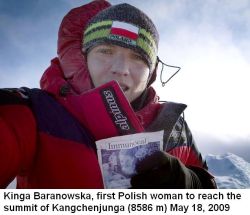Author: Alan Arnette.
To start any article on climbing deaths, it must be said that every death is devastating to family and friends and should never be taken lightly. I have helped bury climbing partners on high peaks and never wish that experience on anyone.
Sadly, mountaineering often receives mainstream media attention only when someone dies and especially on Everest. This was never more true than during the 1996 season that saw 8 people killed in a storm and then in 2006 when another 12 died while climbing. According to Eberhard Jurgalski’s 8000ers.com website, there have been about 4,024 summits since 1922 with 218 deaths or a 5.4% fatality rate.
Since 1990, the deaths have dropped to 4.4% due to better gear, weather forecasting and more rescue resources available, ironically, due to more climbers on the mountain. In 2009, about 281 people made it from the south and 60 from the north. There were 5 deaths. A record 500 people summited in 2007 evenly split between both sides, again with 5 deaths.
I wanted to examine the true statistics behind Everest in the past decade and looked to 8000ers.com for some facts. Based on his tables, the north side fatality rate is more than 2:1 over the south with falls, altitude issues and exhaustion noted as the primary reasons. The difference is even more extreme when the deaths of 9 south side Sherpas are taken from the total, making the ratio of “member or client” climber deaths from north to south 8:1. Here is the summary:
| Reason | North Ridge Route | South Col Route | Other Routes |
| Fall | 7 | 3 | 1 |
| Altitude | 8 | 2 | 1 |
| Exhaustion | 7 | 1 | 1 |
| Unknown | 5 | 1 | 1 |
| Avalanche | 0 | 3 | 2 |
| Crevasse | 0 | 4 | 0 |
| Exposure | 4 | 0 | 0 |
| Heart | 1 | 1 | 0 |
| 32 | 15 | 6 |
That the north side death rate is higher is not a big surprise. The north is traditionally considered slightly more dangerous given the exposure to the cold and harsh winds plus the technical nature of the Steps and exposed rock on the summit ridge.
Due to lower costs, more independent climbers are on the north thus sometimes finding themselves alone in the event of a problem. Also, it seems that more climbers do not use supplemental oxygen on the north than on the south which also can accelerate altitude issues especially in the harshest of conditions.
However, there is no strong correlation between deaths of independent climbers vs climbers on commercial expeditions. Finally, with the exception of 2005 through 2007, the south has had significantly more climbers thus more rescue resources in the event of a problem. Traditionally, commercial operators focused on the south thus fielding more Sherpas.
As far as nationalities, the Nepalese Sherpas suffer the most with 10 of the 53 deaths this decade almost all on the south side from falls, avalanches and crevasse accidents. 6 South Koren climbers have died but no other single nationality has more than 4 deaths in the past decade. As far as operators, no one operator stood out since the majority of the non-Sherpa deaths were of climbers on private national climbs, large shared permits or were climbing independently.
I am often asked which side is safer and my answer is pick your poison. The south has the Khumbu Icefall and the north has the Steps and weather. However these numbers clearly show the north takes a stronger toll. But the real story is the role and impact of the unsung heroes – the Sherpas.
Climb On!
Alan
* Source : – Alan Arnette : 2010 Everest expeditions.
* Previous story :
- Mt.Everest 2010: An Interview with Phil Crampton of Altitude Junkies.
- Everest 2010 season – Expeditions with any British Teams or Britons.
* zapraszam do subskrypcji mojego bloga :
** zapraszam na relacje z wypraw polskich himalaistów.








































0 Response to "The Deadly Side of Mt. Everest."